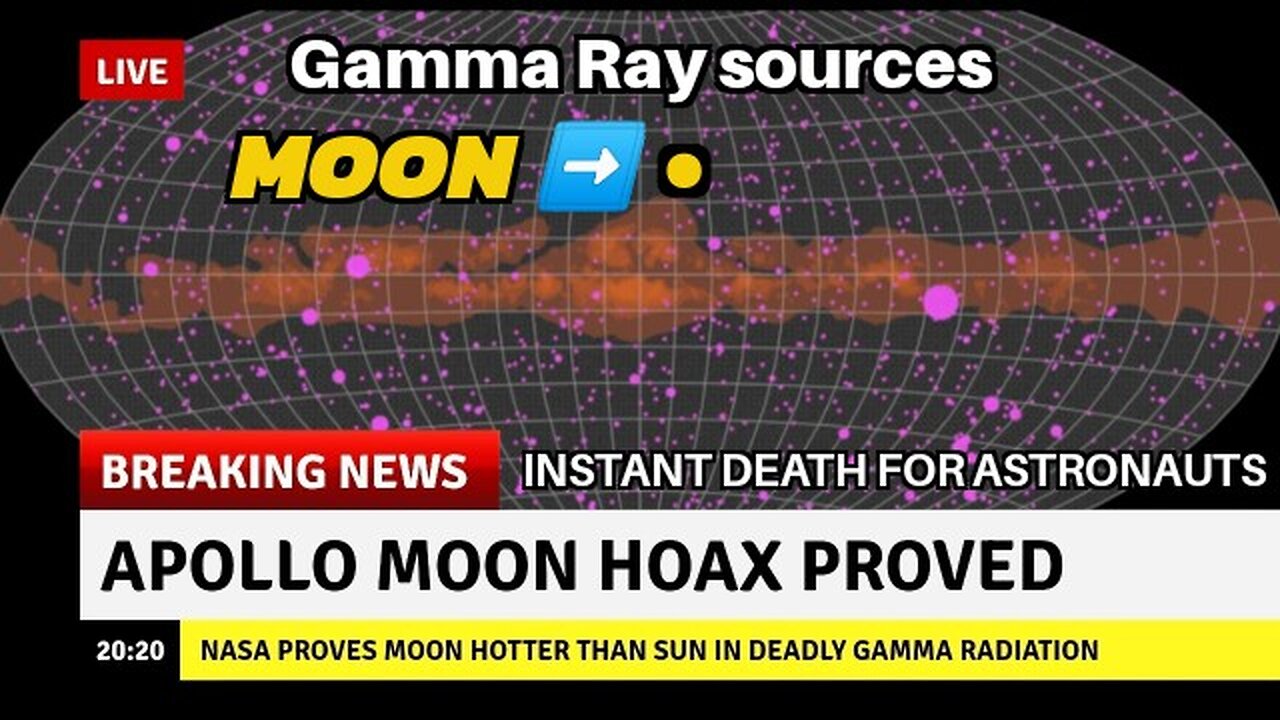Premium Only Content

NASA says the Moon is a trillion times hotter than the Sun in deadly gamma radiation proving Apollo Moon landing is a fraud
Audio version
https://rumble.com/v5osvt8-nasa-says-the-moon-is-hotter-than-the-sun-in-deadly-gamma-radiation-so-moon.html
NASA DID NOT DISCOVER THIS FACT UNTIL 1991, 22 YEARS AFTER FAKE APOLLO MOON LANDING, THAT THE MOON IS HOTTER THAN THE SUN IN DEADLY GAMMA RADIATION. THE MOON IS THE BRIGHTEST GAMMA RAY SOURCE IN THE SKY, BRIGHTER THAN SUPERMASSIVE BLACK HOLES THAT HOLD GALAXIES TOGETHER. THE SUN EMITS ZERO GAMMA RAYS. "THE MOON IS HOTTER THAN THE SUN!" THUS IT IS IMPOSSIBLE FOR HUMANS TO WALK ON THE MOON
Why the Moon is brighter than the Sun (in gamma-rays) . Surprise: the Moon outshines the Sun at the highest energies. Across all wavelengths of light, the Sun is brighter than the Moon. Until we went to the highest energies and saw a gamma-ray surprise.
As the second-brightest object in Earth’s skies behind only the Sun, the Moon’s close proximity explains why no other star, planet, satellite, or galaxy can outshine it. But in all the wavelengths of light we’ve ever seen, from radio waves to infrared to visible light to ultraviolet to X-rays, the Sun is much brighter, as the Moon primarily reflects the Sun’s light. When we launched our first gamma-ray observatory, however, we got quite a shock: the Sun emits no gamma-rays, but the Moon is gamma-ray bright! Here’s the surprising science of why.
If you look at all the objects in Earth’s skies, both natural and artificial, it should come as no surprise that the Sun is the brightest object of all. The Sun, after all, produces its own light, powered by nuclear fusion in its core. That core-generated energy not only holds the Sun up against gravitational collapse, but also propagates to the Sun’s edge, the photosphere, where the Sun emits radiation over a wide range of wavelengths that correspond to a temperature of around 6,000 K. Although the Moon is the second-brightest object that we see, it’s only so bright because of its very close proximity to Earth; most of the Moon’s light, intrinsically, is just reflected light from the Sun.
Because light is quantized into individual “packets” of energy — in the form of photons — there are fewer and fewer photons to observe the higher the energy (and shorter the wavelength) we choose to examine. While the Sun is far and away the brightest light source from X-rays all the way down to radio wavelengths, it emits virtually no gamma-ray photons at all. Only the highest-energy sources of all, such as:
* the regions around black holes,
* neutron stars and pulsars,
* along with supernovae and their remnants,
are capable of emitting them.
This map shows a 1-year view of the entire gamma-ray sky from NASA’s Fermi satellite. The growing-and-shrinking sources are active galaxies powered by supermassive black holes, but the transient “blips” that appear are the gamma-ray bursts that are so sought after, many of which are thought to also create black holes, albeit not the supermassive type. When the Moon enters the field-of-view of the telescope, it can temporarily become the brightest gamma-ray source in the entire sky.
It came as no surprise, then, that the Compton gamma-ray observatory, specifically designed to look for photons with between 20,000,000 and 30,000,000,000 electron-volts of energy (compared to ~2-2.75 electron-volts for visible wavelengths of light), wasn’t really seeing gamma-rays coming from the Sun. Although the Sun creates gamma-rays in its core — where nuclear fusion reactions occur — those gamma-rays typically bounce around for more than 100,000 years before making it to the Sun’s outermost layers. By the time these photons are released, they’ve come down to much lower energies (and in much greater numbers) than the individual gamma-ray photons created by those core nuclear reactions.
Although the Sun can produce gamma-rays during certain flaring events, that isn’t the case for most of the time. Under nearly all circumstances, the Sun is completely gamma-ray quiet.
But during the early phases of the Compton mission, the Moon passed into the Compton gamma-ray observatory’s field of view multiple times, where the EGRET instrument was capable of observing it. Lo and behold, over those same time periods where the Sun was emitting no gamma-rays at all, the Moon appeared bright to Compton’s eyes. The Moon was doing something that the Sun wasn’t — emitting gamma-rays — implying that, somehow, the Moon was doing a whole lot more than just reflecting sunlight.
A diagram of the EGRET instrument, which was used for observing the highest-energy photons aboard the Compton Gamma-Ray Observatory. The EGRET instrument is the only one capable of measuring photons with energies between about 20 MeV up to around 30 GeV: higher energy photons than the Sun typically emits.
This isn’t the case for all the other wavelengths of light emitted by the Moon. Almost all of the Moon’s light, from X-rays to ultraviolet, visible light, infrared, microwave, and radio light, comes from reflecting the light that arrives from the Sun. Even though the Moon re-radiates its absorbed heat as infrared radiation, it’s still the case that the majority of the Moon’s infrared radiation comes from reflected sunlight. But for gamma-rays, that cannot be the case at all.
Continued
https://bigthink.com/starts-with-a-bang/surprise-moon-outshines-sun/
https://en.m.wikipedia.org/wiki/Gamma_ray
https://www.physicsforums.com/threads/conversions-from-mev-to-rad-or-gy.241884/
https://www.nrc.gov/reading-rm/basic-ref/glossary/lethal-dose-ld.html
https://www.schiffsovereign.com/trends/nasa-study-collapse-is-very-difficult-to-avoid-13889/
-
 52:01
52:01
Tucker Carlson
8 hours agoNew York Mayor Eric Adams Sounds a Lot Like a Trump Voter
129K102 -
 2:47:25
2:47:25
Right Side Broadcasting Network
6 hours agoLIVE REPLAY: President Donald J. Trump Holds First Press Briefing Since Inauguration - 1/21/25
185K162 -
 LIVE
LIVE
vivafrei
6 hours agoD.C. Gulag Jan. 6 Prisoners Release Watch!
5,238 watching -
 1:49:14
1:49:14
Redacted News
5 hours agoTrump is Back! Congress Uncovers New Biden Crimes One Day After He Leaves D.C. | Redacted
126K188 -
 2:09:53
2:09:53
Benny Johnson
5 hours ago🚨President Trump LIVE Right Now Making MASSIVE Announcement At White House News Conference
215K235 -
 2:04:10
2:04:10
Revenge of the Cis
6 hours agoEpisode 1433: Retribution
82.9K13 -
 1:42:50
1:42:50
The Criminal Connection Podcast
10 hours ago $0.57 earnedEddie Hearn talks JOSHUA vs FURY, Working With Frank Warren & The Truth About Turki Alalshikh!
32.4K1 -
 1:00:25
1:00:25
In The Litter Box w/ Jewels & Catturd
1 day agoGolden Age | In the Litter Box w/ Jewels & Catturd – Ep. 724 – 1/21/2025
125K57 -
 57:42
57:42
The Dan Bongino Show
13 hours agoHE'S BACK! (Ep. 2405) - 01/21/2025
1.32M2.17K -
 46:19
46:19
Candace Show Podcast
6 hours agoUH-OH! Elon’s Viral Salute Steals The Inauguration Show | Candace Ep 136
136K363